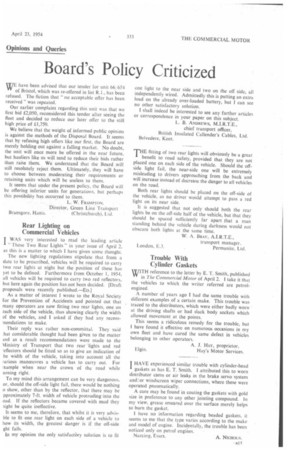Board's Policy Criticized
Page 49

If you've noticed an error in this article please click here to report it so we can fix it.
WE have been advised that our tender for unit 66/654 " of Bristol, which was re-offered in list R.I., has been refused, The fiction that "no acceptable offer has been received" was repeated.
Our earlier complaint regarding this unit was that we first bid £2,050, reconsidered this tender after seeing the fleet and decided to reduce our later offer to the still high price of £1,750.
We believe that the weight of informed public opinion is against the methods of the Disposal Board. It seems that by refusing high offers like our first, the Board are merely holding out against a falling market. No doubt, the unit will once more be offered in the near future, but hauliers like us will tend to reduce their bids rather than raise them. We understand that the Board will still resolutely reject them. Ultimately, they will have to choose between moderating their requirements or retaining units which will be useless to them.
It seems that under the present policy, the Board will be offering inferior units for generations, but perhaps this possibility has occurred to them.
L. W. FRAMPTON,
Director, Green Line Transport Bransgore, Hants. (Christchurch), Ltd.
Rear Lighting on Commercial Vehicles
WAS very interested to read the leading article I Those Two Rear Lights" in your issue of April 2, as this is a matter to which I have given some thought.
The new lighting regulations stipulate that from a date to be prescribed, vehicles will be required to carry two rear lights at night but the position of these has yet to be defined. Furthermore from October 1, 1954, all vehicles will be required to carry two red reflectors, but here again the position has not been decided. [Draft proposals were recently published.—ED.] As a matter of interest I wrote to the Royal Society for the Prevention of Accidents and pointed out that many operators are now fitting two rear lights, one on each side of the vehicle, thus showing clearly the width of the vehicles, and I asked if they had any recommendations to make.
Their reply was rather non-committal. They said .hat considerable thought had been given to the matter tnd as a result recommendations were made to the Ministry of Transport that two rear 'lights and red .eflectors should be fitted so as to give an indication of he width of the vehicle, taking into account all the tarious manceuvres a vehicle has to carry out. For !xarnple when near the crown of the road while urning right.
To my mind this arrangement can be very dangerous, or, should the off-side light fail, there would be nothing o show, other than by the reflector, that there may be pproximately 7-ft. width of vehicle protruding-into the oad. If the reflectors became covered with mud they tight be quite ineffective.
it seems to me, therefore, that whilst it is very advisble to fit one rear light on each side of a vehicle to how its width, the greatest danger is if the off-side ght fails. In my opinion the only satisfactOry solution is to fit one light to the near side and two on the off side, all independently wired. Admittedly this is putting an extra load on the already over-loaded battery, but I can see no other satisfactory solution.
I shall indeed be interested to see any further articles or correspondence in your paper on this subject.
L. B. ANDREWS, chief transport officer, British Insulated Callender's Cables, Ltd. Belvedere, Kent.
THE fitting of two rear lights will obviously be a great
benefit to road safety, provided that they are not placed one on each side of the vehicle. Should the offside light fail, the near-side one will be extremely misleading to drivers approaching from the back and will increase instead of decrease the danger to all vehicles on the road.
Both rear lights should be placed on the off-side of the vehicle, as no driver would attempt to pass a red light on its near side.
It is suggested that not only should both the rear lights be on the off-side half of the vehicle, but that they should be spaced sufficiently far apart that a man standing behind the vehicle during darkness would not obscure both lights at the same time.
W. A. BRAY, A.I.R.T.E., transport manager.
London, E.3. Permanite, Ltd.
Trouble With Cylinder Gaskets
WITH reference to the letter by E. T. Smith, published VT in The Commercial Motor of April 2. I take it that the vehicles to which the writer referred are petrolengined.
A number of years ago I had the same trouble with different examples of a certain make. This trouble was traced to the distributors, which were either badly worn at the driving shafts or had slack body sockets which allowed movement at the points.
This seems a ridiculous remedy for the trouble, but I have found it effective on numerous occasions in my own fleet and have cured the same defect in vehicles belonging to other operators.
A. J. HAY, proprietor, Hay's Motor Services,
HAVE experienced similar trouble with cylinder-head I gaskets as has E. T. Smith. I attributed this to worn distributor cams or air leaks in the brake servo system and/or windscreen wiper connections, where these were operated pneumatically.
A cure may be found in coating the gaskets with gold size in preference to any other jointing compound. In my view, grease smeared over the surface merely helps to burn the gasket.
I have no information regarding beaded gaskets, it seems to me that the type varies according to the make and model of engine. Incidentally, the trouble has been noticed only on petrol engines.
Nazeing, Essex. A. NICHOLS.




















































































